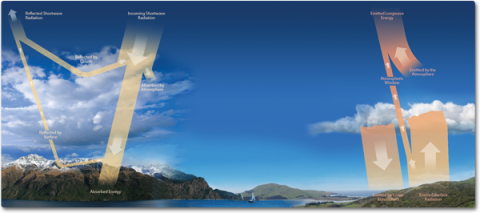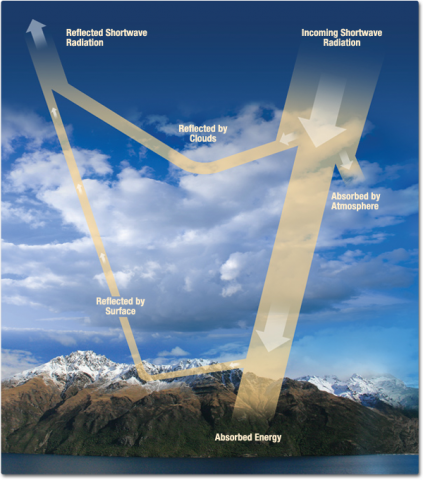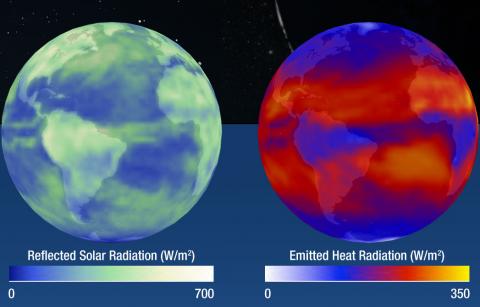
Earth strives to maintain a balance between the overall amount of incoming and outgoing energy at the top of the atmosphere. This is called Earth’s energy budget or Earth's radiation budget. Earth receives incoming energy from the Sun. Earth also emits energy back to space. For Earth’s temperature to be stable over long periods of time (for the energy budget to be in balance), the amount incoming energy and outgoing energy must be equal. If incoming energy is more than outgoing energy, Earth will warm. If outgoing energy is greater than incoming energy, Earth will cool.
Source:
Education Overview – CERES. (2022, April 8). Clouds and the Earth's Radiant Energy System. Retrieved October 6, 2022, from https://ceres.larc.nasa.gov/news/education-overview/#additional-energy-…
NASA: Why does the Sun Matter for Earth’s Energy Budget? | https://www.youtube.com/watch?v=82jE-yvB8xU | Source: NASA Goddard

Earth's Radiation Budget
"Based on the physics principle of conservation of energy, this radiation budget represents the accounting of the balance between incoming radiation, which is almost entirely solar radiation, and outgoing radiation, which is partly reflected solar radiation and partly radiation emitted from the Earth system, including the atmosphere. A budget that's out of balance can cause the temperature of the atmosphere to increase or decrease and eventually affect our climate. The units of energy employed in measuring this incoming and outgoing radiation are watts per square meter (W/m2).
Incoming ultraviolet, visible, and a limited portion of infrared energy (together sometimes called "shortwave radiation") from the Sun drive the Earth's climate system. Some of this incoming radiation is reflected off clouds, some is absorbed by the atmosphere, and some passes through to the Earth's surface. Larger aerosol particles in the atmosphere interact with and absorb some of the radiation, causing the atmosphere to warm. The heat generated by this absorption is emitted as longwave infrared radiation, some of which radiates out into space.

The solar radiation that passes through Earth's atmosphere is either reflected off snow, ice, or other surfaces or is absorbed by the Earth's surface.

Heat resulting from the absorption of incoming shortwave radiation is emitted as longwave radiation. Radiation from the warmed upper atmosphere, along with a small amount from the Earth's surface, radiates out to space. Most of the emitted longwave radiation warms the lower atmosphere, which in turn warms our planet's surface.

Greenhouse gases in the atmosphere (such as water vapor and carbon dioxide) absorb most of the Earth's emitted longwave infrared radiation, which heats the lower atmosphere. In turn, the warmed atmosphere emits longwave radiation, some of which radiates toward the Earth's surface, keeping our planet warm and generally comfortable. Increasing concentrations of greenhouse gases such as carbon dioxide and methane increase the temperature of the lower atmosphere by restricting the outward passage of emitted radiation, resulting in "global warming," or, more broadly, global climate change.
For scientists to understand climate change, they must also determine what drives the changes within the Earth's radiation budget. The Clouds and the Earth's Radiant Energy System (CERES) instrument aboard NASA's Aqua and Terra satellites measures the shortwave radiation reflected and longwave radiation emitted into space accurately enough for scientists to determine the Earth's total radiation budget. Other NASA instruments monitor changes in other aspects of the Earth's climate system—such as clouds, aerosol particles, and surface reflectivity—and scientists are examining their many interactions with the radiation budget."
Source:
National Aeronautics and Space Administration, Science Mission Directorate. (2010). The Earth's Radiation Budget. Retrieved [insert date - e.g. August 10, 2016] , from NASA Science website: http://science.nasa.gov/ems/13_radiationbudget
In order to make reliable projections of climate and plan as a society for potentially significant environmental changes, we need to understand how energy flows through our Earth systems. NASA mission help with this.
NASA's CERES and TSIS Missions
"Research into precise details of Earth's energy budget is vital for understanding how the planet's climate may be changing, as well as variabilities in solar energy output.
NASA’s (The Clouds and the Earth's Radiant Energy System) CERES and NASA's Total and Spectral solar Irradiance Sensor (TSIS-1), missions play key roles in our continued understanding of Earth’s Energy Budget.
NASA’s TSIS helps scientists keep a close watch on the sun’s energy input to Earth. Various satellites have captured a continuous record of this solar energy input since 1978. TSIS-1 sensors advance previous measurements, enabling scientists to study the sun's natural influence on Earth's ozone layer, atmospheric circulation, clouds, and ecosystems. These observations are essential for a scientific understanding of the effects of solar variability on the Earth system.
TSIS-1 makes two key measurements: total solar irradiance, or TSI, the sun's total energy input into Earth, and solar spectral irradiance (SSI), the distribution of the sun's energy input across ultraviolet, visible, and infrared wavelengths of light. TSI measurements are needed to quantify the solar variations in the total amount of energy input to the Earth. SSI measurements are also vital because different wavelengths of light are absorbed by different parts of the atmosphere.
For more than 20 years, NASA Langley's CERES (System) instruments have measured the solar energy reflected by Earth, the heat the planet emits, and the role of clouds in that process. The final CERES Flight Model, CERES FM6 launched aboard NOAA’s JPSS-1 in Fall 2017.
CERES FM6 contributes to an already extensive CERES dataset that helps scientists validate models that calculate the effect of clouds on planetary heating and cooling. The same data can also be helpful for improving near-term, seasonal forecasts influenced by weather events such as El Niño and La Niña. El Niño and La Niña are weather patterns that develop when ocean temperatures fluctuate between warm and cool phases in the Equatorial Pacific Ocean. Built by Northrop Grumman and managed by Langley, CERES FM6 joins five other CERES instruments orbiting the planet on three other satellites.
NASA Goddard Space Flight Center manages the TSIS-1 project. The University of Colorado's Laboratory for Atmospheric and Space Physics (LASP) built both instruments and provides mission operations. The International Space Station carries TSIS-1."
Source:
GMS: Earth's Energy Budget. (2017, July 20). NASA Scientific Visualization Studio. Retrieved October 6, 2022, from https://svs.gsfc.nasa.gov/11937